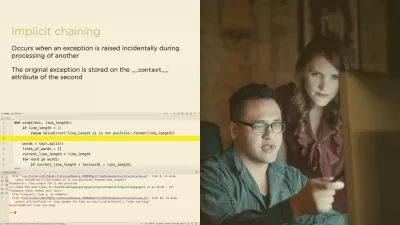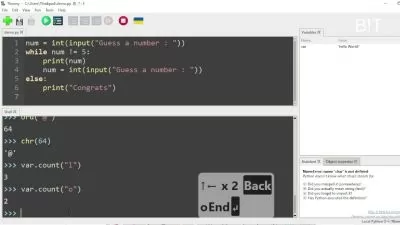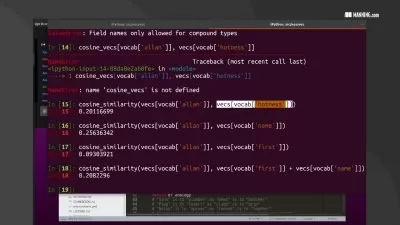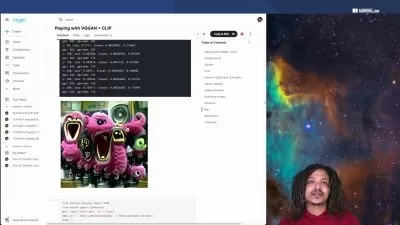01.01-introduction to the course.mp4
00:55
01.02-introduction to the instructor.mp4
05:44
01.03-introduction to the co-instructor.mp4
00:34
01.04-course introduction.mp4
11:16
02.01-what is regular expression.mp4
05:56
02.02-why regular expression.mp4
06:31
02.03-eliza chatbot.mp4
04:23
02.04-python regular expression package.mp4
04:24
03.01-metacharacters.mp4
02:27
03.02-metacharacters bigbrackets exercise.mp4
04:19
03.03-meta characters bigbrackets exercise solution.mp4
03:59
03.04-metacharacters bigbrackets exercise 2.mp4
02:11
03.05-metacharacters bigbrackets exercise 2-solution.mp4
04:37
03.06-metacharacters cap.mp4
03:18
03.07-metacharacters cap exercise 3.mp4
02:03
03.08-metacharacters cap exercise 3-solution.mp4
04:44
03.09-backslash.mp4
05:02
03.10-backslash continued.mp4
07:59
03.11-backslash continued-01.mp4
03:51
03.12-backslash squared brackets exercise.mp4
01:38
03.13-backslash squared brackets exercise solution.mp4
03:58
03.14-backslash squared brackets exercise-another solution.mp4
04:43
03.15-backslash exercise.mp4
01:43
03.16-backslash exercise solution and special sequences exercise.mp4
05:12
03.17-solution and special sequences exercise solution.mp4
04:57
03.18-metacharacter asterisk.mp4
05:18
03.19-metacharacter asterisk exercise.mp4
04:53
03.20-metacharacter asterisk exercise solution.mp4
05:04
03.21-metacharacter asterisk homework.mp4
04:28
03.22-metacharacter asterisk greedy matching.mp4
05:54
03.23-metacharacter plus and question mark.mp4
05:46
03.24-metacharacter curly brackets exercise.mp4
03:25
03.25-metacharacter curly brackets exercise solution.mp4
05:18
04.01-pattern objects.mp4
05:05
04.02-pattern objects match method exercise.mp4
02:43
04.03-pattern objects match method exercise solution.mp4
07:11
04.04-pattern objects match method versus search method.mp4
05:18
04.05-pattern objects finditer method.mp4
03:20
04.06-pattern objects finditer method exercise solution.mp4
06:22
05.01-metacharacters logical or.mp4
06:28
05.02-metacharacters beginning and end patterns.mp4
04:57
05.03-metacharacters parentheses.mp4
07:03
06.01-string modification.mp4
03:49
06.02-word tokenizer using split method.mp4
04:34
06.03-sub method exercise.mp4
04:44
06.04-sub method exercise solution.mp4
04:30
07.01-what is a word.mp4
04:41
07.02-definition of word is task dependent.mp4
05:20
07.03-vocabulary and corpus.mp4
05:38
07.04-tokens.mp4
03:14
07.05-tokenization in spacy.mp4
09:10
08.01-yelp reviews classification mini project introduction.mp4
05:35
08.02-yelp reviews classification mini project vocabulary initialization.mp4
06:48
08.03-yelp reviews classification mini project adding tokens to vocabulary.mp4
04:54
08.04-yelp reviews classification mini project look up functions in vocabulary.mp4
05:57
08.05-yelp reviews classification mini project building vocabulary from data.mp4
09:16
08.06-yelp reviews classification mini project one-hot encoding.mp4
06:51
08.07-yelp reviews classification mini project one-hot encoding implementation.mp4
09:47
08.08-yelp reviews classification mini project encoding documents.mp4
06:50
08.09-yelp reviews classification mini project encoding documents implementation.mp4
06:28
08.10-yelp reviews classification mini project train test splits.mp4
03:41
08.11-yelp reviews classification mini project feature computation.mp4
06:08
08.12-yelp reviews classification mini project classification.mp4
10:45
09.01-tokenization in detial introduction.mp4
04:28
09.02-tokenization is hard.mp4
05:16
09.03-tokenization byte pair encoding.mp4
06:08
09.04-tokenization byte pair encoding example.mp4
08:33
09.05-tokenization byte pair encoding on test data.mp4
07:14
09.06-tokenization byte pair encoding implementation get pair counts.mp4
08:11
09.07-tokenization byte pair encoding implementation merge in corpus.mp4
07:49
09.08-tokenization byte pair encoding implementation bfe training.mp4
06:10
09.09-tokenization byte pair encoding implementation bfe encoding.mp4
06:25
09.10-tokenization byte pair encoding implementation bfe encoding one pair.mp4
09:11
09.11-tokenization byte pair encoding implementation bfe encoding one pair 1.mp4
07:53
10.01-word normalization case folding.mp4
04:43
10.02-word normalization lemmatization.mp4
06:48
10.03-word normalization stemming.mp4
02:31
10.04-word normalization sentence segmentation.mp4
06:27
11.01-spelling correction minimum edit distance introduction.mp4
07:59
11.02-spelling correction minimum edit distance example.mp4
09:04
11.03-spelling correction minimum edit distance table filling.mp4
09:10
11.04-spelling correction minimum edit distance dynamic programming.mp4
07:17
11.05-spelling correction minimum edit distance pseudocode.mp4
03:55
11.06-spelling correction minimum edit distance implementation.mp4
06:57
11.07-spelling correction minimum edit distance implementation bug fixing.mp4
02:40
11.08-spelling correction implementation.mp4
07:42
12.01-what is a language model.mp4
05:50
12.02-language model formal definition.mp4
06:31
12.03-language model curse of dimensionality.mp4
04:27
12.04-language model markov assumption and n-grams.mp4
07:06
12.05-language model implementation setup.mp4
04:24
12.06-language model implementation n-grams function.mp4
08:42
12.07-language model implementation update counts function.mp4
05:46
12.08-language model implementation probability model function.mp4
06:35
12.09-language model implementation reading corpus.mp4
12:17
12.10-language model implementation sampling text.mp4
18:17
13.01-one-hot vectors.mp4
04:10
13.02-one-hot vectors implementation.mp4
05:41
13.03-one-hot vectors limitations.mp4
04:45
13.04-one-hot vectors used as target labeling.mp4
03:42
13.05-term frequency for document representations.mp4
03:12
13.06-term frequency for document representations implementations.mp4
05:31
13.07-term frequency for word representations.mp4
05:17
13.08-tfidf for document representations.mp4
05:01
13.09-tfidf for document representations implementation reading corpus.mp4
04:24
13.10-tfidf for document representations implementation computing document frequency.mp4
04:59
13.11-tfidf for document representations implementation computing tfidf.mp4
07:22
13.12-topic modeling with tfidf 1.mp4
04:20
13.13-topic modeling with tfidf 2.mp4
04:27
13.14-topic modeling with tfidf 3.mp4
04:51
13.15-topic modeling with tfidf 4.mp4
04:40
13.16-topic modeling with gensim.mp4
13:27
14.01-word co-occurrence matrix.mp4
06:25
14.02-word co-occurrence matrix versus document-term matrix.mp4
05:47
14.03-word co-occurrence matrix implementation preparing data.mp4
05:08
14.04-word co-occurrence matrix implementation preparing data 2.mp4
04:12
14.05-word co-occurrence matrix implementation preparing data getting vocabulary.mp4
04:26
14.06-word co-occurrence matrix implementation final function.mp4
11:37
14.07-word co-occurrence matrix implementation handling memory issues on large corpora.mp4
09:19
14.08-word co-occurrence matrix sparsity.mp4
05:19
14.09-word co-occurrence matrix positive point wise mutual information ppmi.mp4
07:58
14.10-pca for dense embeddings.mp4
04:09
14.11-latent semantic analysis.mp4
04:25
14.12-latent semantic analysis implementation.mp4
06:50
15.01-cosine similarity.mp4
07:05
15.02-cosine similarity getting norms of vectors.mp4
09:18
15.03-cosine similarity normalizing vectors.mp4
06:36
15.04-cosine similarity with more than one vector.mp4
11:00
15.05-cosine similarity getting most similar words in the vocabulary.mp4
10:05
15.06-cosine similarity getting most similar words in the vocabulary fixing bug.mp4
06:23
15.07-cosine similarity word2vec embeddings.mp4
08:21
15.08-word analogies.mp4
04:50
15.09-words analogies implementation 1.mp4
05:55
15.10-word analogies implementation 2.mp4
06:13
15.11-word visualizations.mp4
02:16
15.12-word visualizations implementation.mp4
04:28
15.13-word visualizations implementation 2.mp4
06:37
16.01-static and dynamic embeddings.mp4
06:17
16.02-self supervision.mp4
04:23
16.03-word2vec algorithm abstract.mp4
05:21
16.04-word2vec why negative sampling.mp4
03:49
16.05-word2vec what is skip gram.mp4
04:43
16.06-word2vec how to define probability law.mp4
04:00
16.07-word2vec sigmoid.mp4
05:21
16.08-word2vec formalizing loss function.mp4
05:35
16.09-word2vec loss function.mp4
03:25
16.10-word2vec gradient descent step.mp4
04:21
16.11-word2vec implementation preparing data.mp4
10:37
16.12-word2vec implementation gradient step.mp4
07:18
16.13-word2vec implementation driver function.mp4
13:38
17.01-why rnns for nlp.mp4
13:25
17.02-pytorch installation and tensors introduction.mp4
10:32
17.03-automatic differentiation pytorch.mp4
08:26
18.01-why dnns in machine learning.mp4
04:13
18.02-representational power and data utilization capacity of dnn.mp4
07:13
18.03-perceptron.mp4
05:08
18.04-perceptron implementation.mp4
07:26
18.05-dnn architecture.mp4
03:52
18.06-dnn forwardstep implementation.mp4
08:21
18.07-dnn why activation function is required.mp4
04:47
18.08-dnn properties of activation function.mp4
06:04
18.09-dnn activation functions in pytorch.mp4
03:49
18.10-dnn what is loss function.mp4
07:10
18.11-dnn loss function in pytorch.mp4
05:45
19.01-dnn gradient descent.mp4
07:07
19.02-dnn gradient descent implementation.mp4
05:58
19.03-dnn gradient descent stochastic batch minibatch.mp4
06:51
19.04-dnn gradient descent summary.mp4
02:37
19.05-dnn implementation gradient step.mp4
04:02
19.06-dnn implementation stochastic gradient descent.mp4
13:53
19.07-dnn implementation batch gradient descent.mp4
06:46
19.08-dnn implementation minibatch gradient descent.mp4
09:04
19.09-dnn implementation in pytorch.mp4
15:19
20.01-dnn weights initializations.mp4
04:35
20.02-dnn learning rate.mp4
04:03
20.03-dnn batch normalization.mp4
02:05
20.04-dnn batch normalization implementation.mp4
02:41
20.05-dnn optimizations.mp4
04:08
20.06-dnn dropout.mp4
03:58
20.07-dnn dropout in pytorch.mp4
02:03
20.08-dnn early stopping.mp4
03:34
20.09-dnn hyperparameters.mp4
03:33
20.10-dnn pytorch cifar10 example.mp4
15:46
21.01-what is rnn.mp4
04:54
21.02-understanding rnn with a simple example.mp4
08:29
21.03-rnn applications human activity recognition.mp4
02:53
21.04-rnn applications image captioning.mp4
02:37
21.05-rnn applications machine translation.mp4
03:16
21.06-rnn applications speech recognition stock price prediction.mp4
04:04
21.07-rnn models.mp4
07:07
22.01-language modeling next word prediction.mp4
03:43
22.02-language modeling next word prediction vocabulary index.mp4
04:04
22.03-language modeling next word prediction vocabulary index embeddings.mp4
03:16
22.04-language modeling next word prediction rnn architecture.mp4
04:08
22.05-language modeling next word prediction python 1.mp4
07:12
22.06-language modeling next word prediction python 2.mp4
09:02
22.07-language modeling next word prediction python 3.mp4
07:27
22.08-language modeling next word prediction python 4.mp4
05:33
22.09-language modeling next word prediction python 5.mp4
04:35
22.10-language modeling next word prediction python 6.mp4
13:34
23.01-vocabulary implementation.mp4
09:46
23.02-vocabulary implementation helpers.mp4
05:49
23.03-vocabulary implementation from file.mp4
06:26
23.04-vectorizer.mp4
05:17
23.05-rnn setup.mp4
07:20
23.06-rnn setup 1.mp4
21:23
24.01-rnn in pytorch introduction.mp4
02:04
24.02-rnn in pytorch embedding layer.mp4
07:21
24.03-rnn in pytorch nn rnn.mp4
08:47
24.04-rnn in pytorch output shapes.mp4
04:11
24.05-rnn in pytorch gated units.mp4
03:39
24.06-rnn in pytorch gated units gru lstm.mp4
03:55
24.07-rnn in pytorch bidirectional rnn.mp4
02:44
24.08-rnn in pytorch bidirectional rnn output shapes.mp4
04:26
24.09-rnn in pytorch bidirectional rnn output shapes separation.mp4
04:33
24.10-rnn in pytorch example.mp4
09:48
25.01-rnn encoder decoder.mp4
03:01
25.02-rnn attention.mp4
03:28
26.01-introduction to dataset and packages.mp4
05:10
26.02-implementing language class.mp4
05:22
26.03-testing language class and implementing normalization.mp4
09:44
26.04-reading datafile.mp4
05:17
26.05-reading building vocabulary.mp4
07:56
26.06-encoderrnn.mp4
06:14
26.07-decoderrnn.mp4
06:13
26.08-decoderrnn forward step.mp4
12:08
26.09-decoderrnn helper functions.mp4
04:54
26.10-training module.mp4
13:31
26.11-stochastic gradient descent.mp4
07:12
26.12-nmt training.mp4
05:06
26.13-nmt evaluation.mp4
11:13
9781803249193 Code.zip













